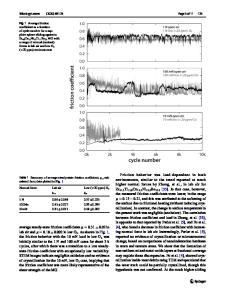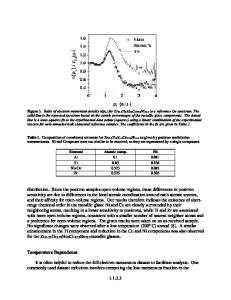Fluctuations of the Local Atomic Environment with Chemical Alloying in Fe Bulk Metallic Glasses
- PDF / 589,720 Bytes
- 5 Pages / 593.972 x 792 pts Page_size
- 24 Downloads / 310 Views
TRODUCTION
THE ability of a system to be cast into glass has defied rigorous scientific understanding in spite of years of research, as glass formation is a complex phenomenon. Amorphous alloys are typically multicomponent systems and are naturally complex.[1–3] To date, numerous alloys, some of which are metallic in nature and with unique physical properties, can be prepared in bulk glass form and at a relatively low synthesis cost.[4–9] A key issue to glass formation involves slowing the kinetics of crystallization in the supercooled liquid. The two factors that contribute to such a slowing are a low diffusivity in the supercooled liquid and a small heat of crystallization, or increase in the stability of the glass in the liquid state hindering crystallization. Understanding the driving mechanisms leading to the stability of an amorphous phase against competing crystalline phases is a central issue to achieving a good glass forming ability. Another key issue involves understanding the role of atomic clusters in the liquid state and how these clusters grow and develop into the short and medium range local order and bonding interactions in the amorphous solid state. The details of how and why atoms organize the way they do are not well understood, particularly in metallic glasses,[10,11] which is the focus of the present work on the Fe bulk glasses.
P. TONG, Research Associate, DESPINA LOUCA, Associate Professor, and S.J. POON, Professor, are with the Department of Physics, University of Virginia, Charlottesville, VA 22904. Contact e-mail: [email protected] X.-J. GU, formerly Research Scientist, with the Department of Physics, University of Virginia, is now Postdoc Researcher, with the Department of Mechanical Engineering, Bucknell University, Lewisburg, PA 17837. G.J. SHIFLET, Professor, is with the Department of Materials Science and Engineering, University of Virginia. T. PROFFEN, Instrument Scientist, is with the Los Alamos National Laboratory, Los Alamos, NM 87545. Manuscript submitted April 14, 2010. Article published online April 13, 2011 METALLURGICAL AND MATERIALS TRANSACTIONS A
The present study examines the local atomic structure of Fe bulk amorphous alloys, because they exhibit several attractive properties potentially useful in applications.[12–14] This includes low or no magnetic transition temperatures,[15] high fracture strength (higher than those of conventional steels), good corrosion, and wear resistance, which can form single phase glassy rods with diameters of the order of 12 mm,[13,15] in addition to the fact that they are relatively cheap to make. A substantial number of studies have focused on modeling binary alloys and provided very detailed descriptions of the local atomic coordination. Multicomponent systems are by far more complex but quite interesting given their mechanical properties. Bulk metallic glasses have the tendency to show local chemical order[16] that may be linked to strong liquid behavior.[17] Atomic cluster formation may appear even in the molten state[18–20] and plays an im
Data Loading...











